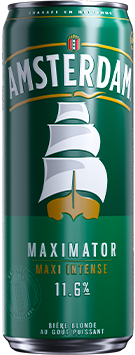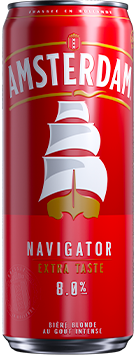

Ingredients of Amsterdam beer
Quality ingredients for a unique taste
Water, malt, hops, yeast: Find out about what goes into Amsterdam beers and about the importance of choosing high-quality ingredients in the brewing process.

Water is the main ingredient of beer
As you will undoubtedly know, beer is made up of 90% water. Choosing the right water is therefore a major factor in brewing as its origin and composition influence the brewing process itself, the beer’s colour and, above all, the taste of the final product. The hardness of the water affects the extent to which the sugars and the malt and hops aromas are released and make the beer more or less bitter.
In the past, breweries were specially built near a well or water source to be sure of a regular supply. Nowadays, the quality of the water is easy to control and can be treated so that it contains the minerals necessary for brewing.
The malt and aromas of Amsterdam beer.
Malt is produced by the cereals which are transformed during the malting process and then mixed with the water. The most commonly used cereal is barley. Its nutritional content makes it the ingredient of choice to obtain a malt which gives full body to the beer.
Depending on the duration and temperature of the drying process and the type of cereal used, it also has an impact on the beer’s alcohol content as well as its smell and colour. For Amsterdam, brewers use moderately roasted Dutch barley malt which gives the beer its golden colour and its caramelised dried fruit aroma.
Hops
The hop is a climbing plant belonging to the hemp family. Brewers gradually started to use it from the 8th century to replace the spices and plants then used to flavour beer. Hops create aroma, offset the sugar of the malt and add a touch of bitterness. They also have antiseptic qualities and are a natural preservative.
Hops can be divided into two categories: Aromatic and bitter. Depending on the flavour which the brewer wants to give their beer, there are several hopping techniques used to bring out more aroma or bitterness: Dry, continuous or late Hopping.
Yeast
Yeast is a microscopic fungus that causes the fermentation process. It is not the most significant ingredient in terms of quantity but it is vital nevertheless. It is a living micro-organism capable of reproducing itself, transforming sugars into alcohol and carbonic gas.
In the past, fermentation was seen as divine intervention. Fermentation was in fact happening thanks to micro-organisms present in the atmosphere. It was only in 1857 that Louis Pasteur explained the secrets of yeast. There are now around 400 species. Each brewery guards its own strain of yeast carefully to avoid infection or contamination.



